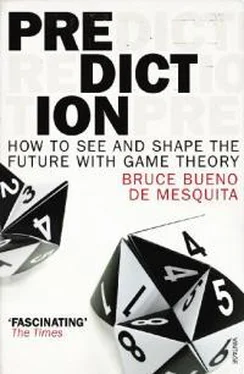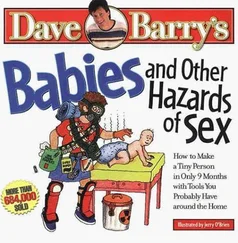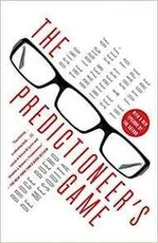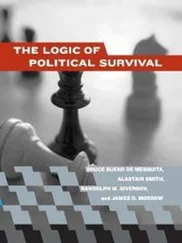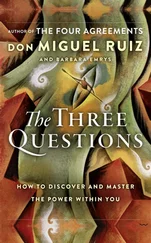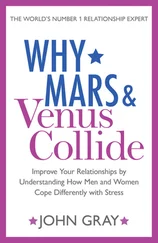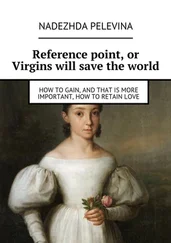When I simulated the prewar 1914 crisis with the British at 90 as their “flexibility” variable, the model indicated that the Austrians and Germans were as uncertain about Britain’s true intentions as they could be. But when I place Britain’s score on this one factor at 50, the model shows that the Germans and the Austrians are convinced that the British will fight. More tellingly, Austria-Hungary’s and Britain’s pattern of interactions change. When Britain shows little resolve, Austria-Hungary anticipates coercing the British into accepting their position. When Britain shows stronger, but not extreme, resolve (50), the Austrians seek a negotiated compromise with the United Kingdom even as they perceive that if Britain is allowed to move first it will mean war. Not, mind you, the little war that Austria sought with Serbia, but the big war that nobody wanted.
Have a look at figure 9.2. Here we see the scenario in which Britain shows more resolve (50 instead of 90). By simulating a tougher British signal, we uncover the sort of intelligence about an adversary’s thinking that would be a lifetime coup for a real-world spy. We discover that with British ships heading for the Adriatic shortly after the start of the crisis, well before war is declared, Austria-Hungary, Germany, and the U.K. perceive the possibility of settling their differences quickly. The Austrians and Germans saw no such prospect (or reason for it) in the simulation of the actual situation. But with the U.K. showing more resolve, the strategic environment is greatly altered. The Austrians and Germans believe that they can and should make a deal with the U.K. in a matter of days after the start of the crisis.
The model says that the Austrians and Germans recognize that they should give up their demand for utter Serbian capitulation. They see an opportunity to persuade the Triple Entente to agree that Austria-Hungary should have real, but not controlling, influence over Serbia’s foreign policy.
Of course, change begets change. The members of the Triple Entente don’t immediately embrace the new offer that (according to the model’s logic) would have been put on the table if the British had sent navy ships to the Adriatic right away. While not caving in to this simulated proposal, the Triple Entente’s diplomats certainly sit up and take notice. The diplomats remain in charge, keeping the generals on the sidelines. While the negotiators hold out for a few weeks, thinking they can extract more concessions from Austria-Hungary, by early August they realize (in the model’s logic—remember, none of this was actually done in 1914) that the Austrians and Germans are highly reluctant to give more. So they take a deal located at about 75 on the 100-point issue scale. That would have given the Austrians more than was put on the table in the real 1914 crisis, but a lot less than the surrender of Serbian sovereignty. It would have more or less split the difference between the British position and the Austro-Hungarian demand. The simulation under these conditions shows that the French and the Russians would have quickly acceded to this compromise. The war to end all wars would have been avoided.
FIG. 9.2. Engineering Successful Negotiations During the 1914 Crisis

Had there but been a thousand mathematicians crunching numbers in London in June 1914, we might not need to ask the next and final question of this chapter: Could World War II have been prevented by the judicious use of a predictioneer’s skills?
NO MORE MISTER HITLER?
The rise to power of Adolf Hitler is a strange and horrendous tale that could have been nipped in the bud sometime between November 1932 and March 1933, if not sooner. It is a tale worth heeding. Whatever else can be said of Hitler, it must be admitted that he was honest and open about his intentions. Not only did his biography, Mein Kampf , published in 1925, announce his ravings to the world; so did he, in campaign speech after campaign speech in 1932. Having failed to come to power in 1923 through an attempted coup d’état (the Beer Hall Putsch, as it is known) in which both German police and Nazi insurgents were killed (and Goering seriously wounded), Hitler was now determined to rise to dictatorial control through legal means. The ballot box would replace the bullet for the moment.
In one campaign stop after another—several per day, as Hitler was the first German politician to take advantage of air travel to cover vast amounts of ground—Hitler declared his intention to ban political parties and suspend the Reichstag, Germany’s parliament, if he came to power. Now, when a campaigner promises peace and prosperity, motherhood and apple pie, we don’t really learn anything about what they plan to do. Being for hope or change or a thousand points of light says nothing. When a politician promises to overturn democracy, that’s a different matter. You don’t lose votes by promising peace and prosperity. I suppose being denied freedom of choice appeals to some people, but certainly not all and probably not many. So when a politician makes such outrageous declarations, we must ask: What does he have in mind? The answer must be that he means what he says. Hitler certainly did.
Of course, we have little need to pay attention to every fringe movement that makes outrageous declarations. But by 1932 the Nazi Party was no fringe movement. The 1930 German election—they ran elections with incredible frequency—gave it 107 out of 577 seats in the Reichstag. In the July 1932 election, the Nazis became the single largest party in the Reichstag, with 230 seats. By then no prudent person could treat Hitler’s campaign promises lightly. Anyone listening should have understood, given the nature of what he was saying, that he meant what he said and he said what he meant. Hitler was a dictator at heart, one hundred percent.
Hitler’s party lost some seats in the November 1932 election but still remained the single largest contingent in the German parliament. The election gave the Nazis 196 seats. By January 1933, Paul von Hindenburg, the beloved and elderly German war hero and president of the Weimar Republic, acquiesced under pressure to make Hitler chancellor. Now the door was wide open to his dictatorial ambitions. In early March 1933 another election was held, almost immediately after the Reichstag fire on March 3. Hitler was quick to blame the Communists for the fire, using that as a pretext to ban them from the Reichstag. He wanted all Communist leaders executed that night—no more Mister Nice Guy—but Hindenburg refused to go along.
The March election was a mixed success for the Nazi Party. On the plus side (from its perspective), the party increased its seat share in the Reichstag from 196 to 288. On the minus side, the Nazis failed to gain a majority. That meant Hitler still had to make deals with other parties; he was not yet completely in control. He was still vulnerable to defeat if a strong enough coalition of parties in the Reichstag joined together to oppose him. The tragedy is that they didn’t.
Shortly after the March 5 election, on March 23, 1933, he negotiated his way to a two-thirds vote in the Reichstag to change the constitution to comply with the terms of the Enabling Act, a piece of legislation to make him dictator. The Enabling Act gave Hitler as chancellor essentially all of the constitutional authority also granted to the Reichstag so that he no longer needed legislative approval for policy changes he wished to put in place. The Enabling Act made Hitler Germany’s dictator and ended the need for future elections. He was well on the way to doing everything he had promised to do during the previous election campaigns.
Читать дальше
